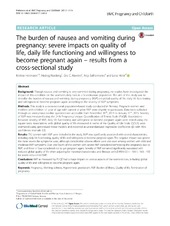| dc.contributor.author | Heitmann, Kristine | en_US |
| dc.contributor.author | Nordeng, Hedvig Marie Egeland | en_US |
| dc.contributor.author | Havnen, Gro Cecilie | en_US |
| dc.contributor.author | Solheimsnes, Anja | en_US |
| dc.contributor.author | Holst, Lone | en_US |
| dc.date.accessioned | 2018-09-06T11:57:35Z | |
| dc.date.available | 2018-09-06T11:57:35Z | |
| dc.date.issued | 2017-02-28 | |
| dc.Published | Heitmann K, Nordeng HME, Havnen GC, Solheimsnes A, Holst L. The burden of nausea and vomiting during pregnancy: severe impacts on quality of life, daily life functioning and willingness to become pregnant again – results from a cross-sectional study. BMC Pregnancy and Childbirth. 2017;17:75 | eng |
| dc.identifier.issn | 1471-2393 | |
| dc.identifier.uri | https://hdl.handle.net/1956/18421 | |
| dc.description.abstract | Background: Though nausea and vomiting is very common during pregnancy, no studies have investigated the impact of this condition on the women’s daily lives in a Scandinavian population. The aim of this study was to describe the burden of nausea and vomiting during pregnancy (NVP) on global quality of life, daily life functioning and willingness to become pregnant again according to the severity of NVP symptoms. Methods: This study is a cross-sectional population-based study conducted in Norway. Pregnant women and mothers with children <1 year of age with current or prior NVP were eligible to participate. Data were collected through an anonymous on-line questionnaire accessible from November 10th, 2014 to January 31st, 2015. Severity of NVP was measured using the 24-h Pregnancy Unique Quantification of Emesis Scale (PUQE). Associations between severity of NVP, daily life functioning and willingness to become pregnant again were tested using chisquare tests. Associations with global quality of life measured in terms of the Quality of Life Scale (QOLS) were estimated using generalized linear models and reported as unstandardized regression coefficients (β) with 95% confidence intervals (CI). Results: 712 women with NVP were included in the study. NVP was significantly associated with several characteristics, including daily life functioning, quality of life and willingness to become pregnant again. The negative impact was greater the more severe the symptoms were, although considerable adverse effects were also seen among women with mild and moderate NVP symptoms. Over one fourth of the women with severe NVP considered terminating the pregnancy due to NVP, and three in four considered not to get pregnant again. Severity of NVP remained significantly associated with reduced global quality of life when adjusting for maternal characteristics and illnesses with β (95% CI) = −10.9 (−16.9, −4.9) for severe versus mild NVP. Conclusions: NVP as measured by PUQE had a major impact on various aspects of the women’s lives, including global quality of life and willingness to become pregnant again. | en_US |
| dc.language.iso | eng | eng |
| dc.publisher | BioMed Central | eng |
| dc.rights | Attribution CC BY | eng |
| dc.rights.uri | http://creativecommons.org/licenses/by/4.0 | eng |
| dc.subject | Pregnancy | eng |
| dc.subject | Morning sickness | eng |
| dc.subject | Hyperemesis gravidarum | eng |
| dc.subject | NVP | eng |
| dc.subject | Burden of illness | eng |
| dc.subject | Quality of life | eng |
| dc.subject | Termination of pregnancy | eng |
| dc.title | The burden of nausea and vomiting during pregnancy: severe impacts on quality of life, daily life functioning and willingness to become pregnant again – results from a cross-sectional study | en_US |
| dc.type | Peer reviewed | |
| dc.type | Journal article | |
| dc.date.updated | 2018-03-05T14:02:28Z | |
| dc.description.version | publishedVersion | en_US |
| dc.rights.holder | Copyright 2017 The Author(s) | |
| dc.identifier.doi | https://doi.org/10.1186/s12884-017-1249-0 | |
| dc.identifier.cristin | 1570536 | |
| dc.source.journal | BMC Pregnancy and Childbirth | |

